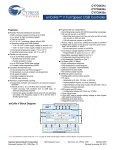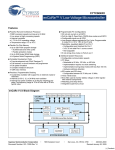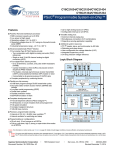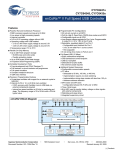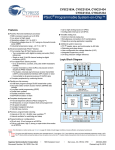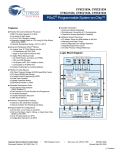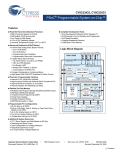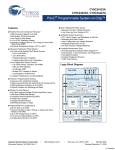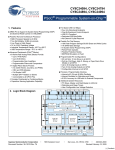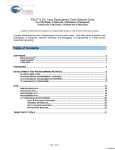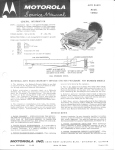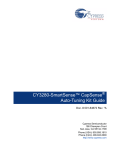Download Cypress CapSense CY8C20x36 User's Manual
Transcript
CY8C20x36/46/66, CY8C20396 CapSense™ Applications Features ■ 1.71V to 5.5V Operating Range ■ Low Power CapSense™ Block ❐ Configurable Capacitive Sensing Elements ❐ Supports Combination of CapSense Buttons, Sliders, Touchpads, Touch Screens, and Proximity Sensor ■ Powerful Harvard Architecture Processor ❐ M8C Processor Speeds Running to 24 MHz ❐ Low Power at High Speed ❐ Interrupt Controller ❐ Temperature Range: -40°C to +85°C ■ Flexible On-Chip Memory ❐ Three Program/Data Storage Size Options: • CY8C20x36: 8K Flash / 1K SRAM • CY8C20x46: 16K Flash / 2K SRAM • CY8C20x66: 32K Flash / 2K SRAM ❐ 50,000 Flash Erase/Write Cycles ❐ Partial Flash Updates ❐ Flexible Protection Modes ❐ In-System Serial Programming (ISSP) ■ Full-Speed USB ❐ Available on CY8C20396 and CY8C20666 Only ❐ 12 Mbps USB 2.0 Compliant ❐ Eight Unidirectional Endpoints ❐ One Bidirectional Control Endpoint ❐ Dedicated 512 Byte Buffer ❐ Internally Regulated at 3.3V ■ Precision, Programmable Clocking ❐ Internal Main Oscillator: 6/12/24 MHz ± 5% ❐ Internal Low Speed Oscillator at 32 kHz for Watchdog and Sleep Timers ❐ Precision 32 kHz Oscillator for Optional External Crystal (CY8C20x46/66 only) ❐ 0.25% Accuracy for USB with No External Components (CY8C20396 and CY8C20666 only) ■ Programmable Pin Configurations ❐ Up to 36 GPIO (Depending on Package) ❐ Dual Mode GPIO: All GPIO Support Digital IO and Analog Input ❐ 25 mA Sink Current on All GPIO ❐ Pull up, High Z, Open Drain Modes on All GPIO ❐ CMOS Drive Mode(5 mA Source Current) on Ports 0 and 1: • 20 mA (at 3.0V) Total Source Current on Port 0 • 20 mA (at 3.0V) Total Source Current on Port 1 ❐ Selectable, Regulated Digital IO on Port 1 ❐ Configurable Input Threshold on Port 1 ❐ Hot Swap Capability on all Port 1 GPIO Cypress Semiconductor Corporation Document Number: 001-12696 Rev. *D • ■ Versatile Analog Mux ❐ Common Internal Analog Bus ❐ Simultaneous Connection of IO ❐ High PSRR Comparator ❐ Low Dropout Voltage Regulator for All Analog Resources ■ Additional System Resources 2 ❐ I C™ Slave: • Selectable to 50 kHz, 100 kHz, or 400 kHz • No Clock Stretching Required (under most conditions) • Implementation During Sleep Modes with Less Than 100 µA • Hardware Address Validation ❐ SPI™ Master and Slave: Configurable 46.9 kHz - 12 MHz ❐ Three 16-Bit Timers ❐ Watchdog and Sleep Timers ❐ Internal Voltage Reference ❐ Integrated Supervisory Circuit ■ Complete Development Tools ❐ Free Development Tool (PSoC Designer™) ❐ Full Featured, In-Circuit Emulator and Programmer ❐ Full Speed Emulation ❐ Complex Breakpoint Structure ❐ 128K Trace Memory ■ Package Options ❐ CY8C20x36: • 16-Pin 3 x 3 x 0.6 mm QFN • 24-Pin 4 x 4 x 0.6 mm QFN • 32-Pin 5 x 5 x 0.6 mm QFN ❐ CY8C20x46: • 16-Pin 3 x 3 x 0.6 mm QFN • 24-Pin 4 x 4 x 0.6 mm QFN • 32-Pin 5 x 5 x 0.6 mm QFN ❐ CY8C20396: 24-Pin 4 x 4 x 0.6 mm QFN ❐ CY8C20x66: • 32-Pin 5 x 5 x 0.6 mm QFN • 48-Pin 7 x 7 x 1.0 mm QFN (with USB) • 48-Pin SSOP 198 Champion Court • San Jose, CA 95134-1709 • 408-943-2600 Revised March 17, 2009 [+] Feedback CY8C20x36/46/66, CY8C20396 Block Diagram Port 4 Port 3 Port 2 Port 1 Port 0 1.8/2.5/3V LDO PWRSYS (Regulator) PSoC CORE SYSTEM BUS Global Analog Interconnect 1K/2K SRAM Supervisory ROM (SROM) Interrupt Controller 8K/16K/32K Flash Nonvolatile Memory Sleep and Watchdog CPU Core (M8C) 6/12/24 MHz Internal Main Oscillator (IMO) Internal Low Speed Oscillator (ILO) Multiple Clock Sources CAPSENSE SYSTEM Analog Reference CapSense Module Two Comparators Analog Mux SYSTEM BUS USB I2C Slave Internal Voltage References System Resets POR and LVD SPI Master/ Slave Three 16-Bit Programmable Timers Digital Clocks SYSTEM RESOURCES Document Number: 001-12696 Rev. *D Page 2 of 34 [+] Feedback CY8C20x36/46/66, CY8C20396 PSoC® Functional Overview Figure 1. Analog System Block Diagram The PSoC family consists of on-chip Controller devices. These devices are designed to replace multiple traditional MCU-based components with one, low cost single-chip programmable component. A PSoC device includes configurable analog and digital blocks, and programmable interconnect. This architecture allows the user to create customized peripheral configurations, to match the requirements of each individual application. Additionally, a fast CPU, Flash program memory, SRAM data memory, and configurable IO are included in a range of convenient pinouts. Analog Global Bus IDAC Vr The architecture for this device family, as shown in the Block Diagram on page 2, is comprised of three main areas: the Core, the CapSense Analog System, and the System Resources (including a full speed USB port). A common, versatile bus allows connection between IO and the analog system. Each CY8C20x36/46/66, CY8C20396 PSoC device includes a dedicated CapSense block that provides sensing and scanning control circuitry for capacitive sensing applications. Depending on the PSoC package, up to 36 general purpose IO (GPIO) are also included. The GPIO provides access to the MCU and analog mux. Reference Buffer Cinternal Comparator Mux Mux Refs PSoC Core CapSenseCounters The PSoC Core is a powerful engine that supports a rich instruction set. It encompasses SRAM for data storage, an interrupt controller, sleep and watchdog timers, and IMO (internal main oscillator) and ILO (internal low speed oscillator). The CPU core, called the M8C, is a powerful processor with speeds up to 24 MHz. The M8C is a four-MIPS, 8-bit Harvard architecture microprocessor. System Resources provide additional capability, such as configurable USB and I2C slave/SPI master-slave communication interface, three 16-bit programmable timers, and various system resets supported by the M8C. The Analog System is composed of the CapSense PSoC block and an internal 1.2V analog reference, which together support capacitive sensing of up to 36 inputs. CapSense Analog System The Analog System contains the capacitive sensing hardware. Several hardware algorithms are supported. This hardware performs capacitive sensing and scanning without requiring external components. Capacitive sensing is configurable on each GPIO pin. Scanning of enabled CapSense pins are completed quickly and easily across multiple ports. CSCLK IMO CapSense Clock Select Oscillator Analog Multiplexer System The Analog Mux Bus can connect to every GPIO pin. Pins are connected to the bus individually or in any combination. The bus also connects to the analog system for analysis with the CapSense block comparator. Switch control logic enables selected pins to precharge continuously under hardware control. This enables capacitive measurement for applications such as touch sensing. Other multiplexer applications include: ■ Complex capacitive sensing interfaces, such as sliders and touchpads. ■ Chip-wide mux that allows analog input from any IO pin. ■ Crosspoint connection between any IO pin combinations. When designing capacitive sensing applications, refer to the latest signal-to-noise signal level requirements Application Notes, which can be found under http://www.cypress.com >> Documentation >> Application Notes. In general, and unless otherwise noted in the relevant Application Notes, the minimum signal-to-noise ratio (SNR) for CapSense applications is 5:1. Document Number: 001-12696 Rev. *D Page 3 of 34 [+] Feedback CY8C20x36/46/66, CY8C20396 Additional System Resources System Resources, some of which are listed in the previous sections, provide additional capability useful to complete systems. Additional resources include low voltage detection and power on reset. The merits of each system resource are listed here: Getting Started The quickest way to understand PSoC silicon is to read this data sheet and then use the PSoC Designer Integrated Development Environment (IDE). This data sheet is an overview of the PSoC integrated circuit and presents specific pin, register, and electrical specifications. ■ The I2C slave/SPI master-slave module provides 50/100/400 kHz communication over two wires. SPI communication over three or four wires runs at speeds of 46.9 kHz to 3 MHz (lower for a slower system clock). ■ The I2C hardware address recognition feature reduces the already low power consumption by eliminating the need for CPU intervention until a packet addressed to the target device is received. Application Notes ■ Low Voltage Detection (LVD) interrupts can signal the application of falling voltage levels, while the advanced POR (Power-On-Reset) circuit eliminates the need for a system supervisor. Application notes are an excellent introduction to the wide variety of possible PSoC designs. They are located here: www.cypress.com/psoc. Select Application Notes under the Documentation tab. ■ An internal reference provides an absolute reference for capacitive sensing. Development Kits ■ The 5.5V maximum input, 1.8/2.5/3V-selectable output, lowdropout regulator (LDO) provides regulation for IOs. A registercontrolled bypass mode allows the user to disable the LDO. ■ Standard Cypress PSoC IDE tools are available for debugging the CY8C20x36/46/66, CY8C20396 family of parts. However, the additional trace length and a minimal ground plane in the Flex-Pod can create noise problems that make it difficult to debug a Power PSoC design. A custom bonded On-Chip Debug (OCD) device is available in an 48-pin QFN package. The OCD device is recommended for debugging designs that have high current and/or high analog accuracy requirements. The QFN package is compact and is connected to the ICE through a high density connector. For in depth information, along with detailed programming details, see the PSoC® Programmable System-on-Chip™ Technical Reference Manual for CY8C28xxx PSoC devices. For up-to-date ordering, packaging, and electrical specification information, see the latest PSoC device data sheets on the web at www.cypress.com/psoc. PSoC Development Kits are available online from Cypress at www.cypress.com/shop and through a growing number of regional and global distributors, which include Arrow, Avnet, DigiKey, Farnell, Future Electronics, and Newark. Training Free PSoC technical training (on demand, webinars, and workshops) is available online at www.cypress.com/training. The training covers a wide variety of topics and skill levels to assist you in your designs. CYPros Consultants Certified PSoC Consultants offer everything from technical assistance to completed PSoC designs. To contact or become a PSoC Consultant go to www.cypress.com/cypros. Solutions Library Visit our growing library of solution focused designs at www.cypress.com/solutions. Here you can find various application designs that include firmware and hardware design files that enable you to complete your designs quickly. Technical Support For assistance with technical issues, search KnowledgeBase articles and forums at www.cypress.com/support. If you cannot find an answer to your question, call technical support at 1-800541-4736. Document Number: 001-12696 Rev. *D Page 4 of 34 [+] Feedback CY8C20x36/46/66, CY8C20396 Development Tools PSoC Designer™ is a Microsoft® Windows-based, integrated development environment for the Programmable System-onChip (PSoC) devices. The PSoC Designer IDE and application runs on Windows XP and Windows Vista. This system provides design database management by project, an integrated debugger with In-Circuit Emulator, in-system programming support, and built-in support for third-party assemblers and C compilers. PSoC Designer also supports C language compilers developed specifically for the devices in the PSoC family. PSoC Designer Software Subsystems System-Level View The system-level view is a drag-and-drop visual embedded system design environment based on PSoC Express. In this view you solve design problems the same way you might think about the system. Select input and output devices based upon system requirements. Add a communication interface and define the interface to the system (registers). Define when and how an output device changes state based upon any/all other system devices. Based upon the design, PSoC Designer automatically selects one or more PSoC devices that match your system requirements. PSoC Designer generates all embedded code, then compiles and links it into a programming file for a specific PSoC device. Chip-Level View The chip-level view is a more traditional integrated development environment (IDE) based on PSoC Designer 4.x. You choose a base device to work with and then select different onboard analog and digital components called user modules that use the PSoC blocks. Examples of user modules are ADCs, DACs, Amplifiers, and Filters. You configure the user modules for your chosen application and connect them to each other and to the proper pins. Then you generate your project. This prepopulates your project with APIs and libraries that you can use to program your application. The tool also supports easy development of multiple configurations and dynamic reconfiguration. Dynamic reconfiguration allows for changing configurations at run time. Hybrid Designs You can begin in the system-level view, allow it to choose and configure your user modules, routing, and generate code, then switch to the chip-level view to gain complete control over onchip resources. All views of the project share common code editor, builder, and common debug, emulation, and programming tools. Document Number: 001-12696 Rev. *D Code Generation Tools PSoC Designer supports multiple third-party C compilers and assemblers. The code generation tools work seamlessly within the PSoC Designer interface and have been tested with a full range of debugging tools. The choice is yours. Assemblers. The assemblers allow assembly code to be merged seamlessly with C code. Link libraries automatically use absolute addressing or are compiled in relative mode, and linked with other software modules to get absolute addressing. C Language Compilers. C language compilers are available that support the PSoC family of devices. The products allow you to create complete C programs for the PSoC family devices. The optimizing C compilers provide all the features of C tailored to the PSoC architecture. They come complete with embedded libraries providing port and bus operations, standard keypad and display support, and extended math functionality. Debugger PSoC Designer has a debug environment that provides hardware in-circuit emulation, allowing you to test the program in a physical system while providing an internal view of the PSoC device. Debugger commands allow the designer to read and program and read and write data memory, read and write IO registers, read and write CPU registers, set and clear breakpoints, and provide program run, halt, and step control. The debugger also allows the designer to create a trace buffer of registers and memory locations of interest. Online Help System The online help system displays online, context-sensitive help for the user. Designed for procedural and quick reference, each functional subsystem has its own context-sensitive help. This system also provides tutorials and links to FAQs and an Online Support Forum to aid the designer in getting started. In-Circuit Emulator A low cost, high functionality ICE (In-Circuit Emulator) is available for development support. This hardware has the capability to program single devices. The emulator consists of a base unit that connects to the PC by way of a USB port. The base unit is universal and operates with all PSoC devices. Emulation pods for each device family are available separately. The emulation pod takes the place of the PSoC device in the target board and performs full speed (24 MHz) operation. Page 5 of 34 [+] Feedback CY8C20x36/46/66, CY8C20396 Designing with PSoC Designer The development process for the PSoC device differs from that of a traditional fixed function microprocessor. The configurable analog and digital hardware blocks give the PSoC architecture a unique flexibility that pays dividends in managing specification change during development and by lowering inventory costs. These configurable resources, called PSoC Blocks, have the ability to implement a wide variety of user-selectable functions. The PSoC development process can be summarized in the following four steps: 1. Select Components 2. Configure Components 3. Organize and Connect 4. Generate, Verify, and Debug Select Components Organize and Connect You build signal chains at the chip level by interconnecting user modules to each other and the IO pins, or connect system-level inputs, outputs, and communication interfaces to each other with valuator functions. In the system-level view selecting a potentiometer driver to control a variable speed fan driver and setting up the valuators to control the fan speed based on input from the pot selects, places, routes, and configures a programmable gain amplifier (PGA) to buffer the input from the potentiometer, an analog-todigital converter (ADC) to convert the potentiometer’s output to a digital signal, and a PWM to control the fan. In the chip-level view, you perform the selection, configuration, and routing so that you have complete control over the use of all on-chip resources. Both the system-level and chip-level views provide a library of pre-built, pre-tested hardware peripheral components. In the system-level view these components are called “drivers” and correspond to inputs (a thermistor, for example), outputs (a brushless DC fan, for example), communication interfaces (I2Cbus, for example), and the logic to control how they interact with one another (called valuators). Generate, Verify, and Debug In the chip-level view the components are called “user modules.” User modules make selecting and implementing peripheral devices simple, and come in analog, digital, and programmable system-on-chip varieties. Both system-level and chip-level designs generate software based on your design. The chip-level design provides application programming interfaces (APIs) with high-level functions to control and respond to hardware events at run time and interrupt service routines that you can adapt as needed. The system-level design also generates a C main() program that completely controls the chosen application and contains placeholders for custom code at strategic positions allowing you to further refine the software without disrupting the generated code. Configure Components Each of the components you select establishes the basic register settings that implement the selected function. They also provide parameters and properties that allow you to tailor their precise configuration to your particular application. For example, a Pulse Width Modulator (PWM) User Module configures one or more digital PSoC blocks, one for each 8 bits of resolution. The user module parameters permit you to establish the pulse width and duty cycle. Configure the parameters and properties to correspond to your chosen application. Enter values directly or by selecting values from drop-down menus. Both the system-level drivers and chip-level user modules are documented in data sheets that are viewed directly in PSoC Designer. These data sheets explain the internal operation of the component and provide performance specifications. Each data sheet describes the use of each user module parameter or driver property, and other information you may need to successfully implement your design. Document Number: 001-12696 Rev. *D When you are ready to test the hardware configuration or move on to developing code for the project, you perform the “Generate Configuration Files” step. This causes PSoC Designer to generate source code that automatically configures the device to your specification and provides the software for the system. A complete code development environment allows you to develop and customize your applications in C, assembly language, or both. The last step in the development process takes place inside PSoC Designer’s Debugger (access by clicking the Connect icon). PSoC Designer downloads the HEX image to the In-Circuit Emulator (ICE) where it runs at full speed. PSoC Designer debugging capabilities rival those of systems costing many times more. In addition to traditional single-step, run-to-breakpoint and watch-variable features, the debug interface provides a large trace buffer and allows you to define complex breakpoint events that include monitoring address and data bus values, memory locations and external signals. Page 6 of 34 [+] Feedback CY8C20x36/46/66, CY8C20396 Document Conventions Acronyms Used Units of Measure The following table lists the acronyms that are used in this document. A units of measure table is located in the Electrical Specifications section. Table 9 on page 15 lists all the abbreviations used to measure the PSoC devices. Table 1. Acronyms Acronym Description AC alternating current API application programming interface CPU central processing unit DC direct current FSR full scale range GPIO general purpose IO GUI graphical user interface ICE in-circuit emulator ILO internal low speed oscillator IMO internal main oscillator IO input/output LSb least-significant bit LVD low voltage detect MSb most-significant bit POR power on reset PPOR precision power on reset PSoC® Programmable System-on-Chip™ SLIMO slow IMO SRAM static random access memory Document Number: 001-12696 Rev. *D Numeric Naming Hexadecimal numbers are represented with all letters in uppercase with an appended lowercase ‘h’ (for example, ‘14h’ or ‘3Ah’). Hexadecimal numbers may also be represented by a ‘0x’ prefix, the C coding convention. Binary numbers have an appended lowercase ‘b’ (for example, 01010100b’ or ‘01000011b’). Numbers not indicated by an ‘h’, ‘b’, or 0x are decimal. Page 7 of 34 [+] Feedback CY8C20x36/46/66, CY8C20396 Pinouts The CY8C20x36/46/66, CY8C20396 PSoC device is available in a variety of packages which are listed and illustrated in the following tables. Every port pin (labeled with a “P”) is capable of Digital IO and connection to the common analog bus. However, Vss, Vdd, and XRES are not capable of Digital IO. 16-Pin QFN Table 2. Pin Definitions - CY8C20236, CY8C20246 PSoC Device [2] P1[7] I2C SCL, SPI SS 4 IOHR I P1[5] I2C SDA, SPI MISO 5 IOHR I P1[3] SPI CLK 6 IOHR I P1[1] ISSP CLK[1], I2C SCL, SPI MOSI 7 Power Vss Ground connection 8 IOHR I P1[0] ISSP DATA[1], I2C SDA, SPI CLK 9 IOHR I P1[2] 10 IOHR I P1[4] Optional external clock (EXTCLK) 11 12 13 Input IOH AI, XOut, P2[5] AI, XIn, P2[3] AI, I2C SCL, SPI SS, P1[7] AI, I2C SDA, SPI MISO, P1[5] 1 2 3 4 I 12 QFN (Top View) 11 XRES Active high external reset with internal pull down Power 14 13 P2[3] Crystal input (XIn) I 10 9 8 I IOHR 7 IO 3 Vss 2 AI, DATA1, I2C SDA, SPI CLK, P1[0] P2[5] Crystal output (XOut) P0[1], AI P0[3], AI P0[7], AI Vdd I Figure 2. CY8C20236, CY8C20246 PSoC Device 16 15 Analog IO Description 5 6 Digital 1 Name AI, SPI CLK, P1[3] AI, CLK1, SPI MOSI, P1[1] Type Pin No. P0[4], AI XRES P1[4], EXTCLK, AI P1[2], AI P0[4] Vdd Supply voltage 14 IOH I P0[7] 15 IOH I P0[3] Integrating input 16 IOH I P0[1] Integrating input LEGEND A = Analog, I = Input, O = Output, OH = 5 mA High Output Drive, R = Regulated Output. Notes 1. These are the ISSP pins, which are not High Z at POR (Power On Reset). 2. During power up or reset event, device P1[1] and P1[0] may disturb the I2C bus. Use alternate pins if you encounter any issues. Document Number: 001-12696 Rev. *D Page 8 of 34 [+] Feedback CY8C20x36/46/66, CY8C20396 24-Pin QFN Table 3. Pin Definitions - CY8C20336, CY8C20346 [2, 3] I P1[7] I2C SCL, SPI SS 5 IOHR I P1[5] I2C SDA, SPI MISO 6 IOHR I P1[3] SPI CLK 7 IOHR I P1[1] ISSP CLK[1], I2C SCL, SPI MOSI 8 9 Power NC No connection Vss Ground connection ISSP DATA[1], I2C SDA, SPI CLK 10 IOHR I P1[0] 11 IOHR I P1[2] 12 IOHR I P1[4] 13 IOHR I P1[6] 14 Input XRES 15 IO I P2[0] 16 IOH I P0[0] 17 IOH I P0[2] 18 IOH I P0[4] 19 IOH I P0[6] 20 Power Vdd 1 18 17 2 3 QFN 16 4 (Top View) 15 5 14 6 13 P0[4], AI P0[2], AI P0[0], AI P2[0], AI XRES P1[6], AI Active high external reset with internal pull down Supply voltage IOH I P0[7] 22 IOH I P0[5] 23 IOH I P0[3] Integrating input 24 IOH I P0[1] Integrating input Vss Center pad must be connected to ground Power AI, P2[1] AI, I2C SCL, SPI SS, P1[7] AI, I2C SDA, SPI MISO, P1[5] AI, SPI CLK, P1[3] Optional external clock input (EXTCLK) 21 CP AI, XOut, P2[5] AI, XIn, P2[3] 19 IOHR 21 4 20 Crystal input (XIn) P2[1] 11 12 P2[3] I 22 I IO 9 IO 3 10 2 AI, DATA2, I2C SDA, SPI CLK, P1[0] AI, P1[2] AI, EXTCLK, P1[4] Crystal output (XOut) P0[1], AI P0[3], AI P0[5], AI P0[7], AI Vdd P0[6], AI P2[5] 24 I 23 IO 8 1 Figure 3. CY8C20336, CY8C20346 PSoC Device 7 Description AI, CLK2, I2C SCL SPI MOSI, P1[1] NC Vss Type Pin No. Digital Analog Name LEGEND A = Analog, I = Input, O = Output, OH = 5 mA High Output Drive, R = Regulated Output. Note 3. The center pad (CP) on the QFN package must be connected to ground (Vss) for best mechanical, thermal, and electrical performance. If not connected to ground, it must be electrically floated and not connected to any other signal. Document Number: 001-12696 Rev. *D Page 9 of 34 [+] Feedback CY8C20x36/46/66, CY8C20396 24-Pin QFN with USB Pinout Table 4. Pin Definitions - CY8C20396 PSoC Device [2, 3] Name Description 1 IO I P2[5] 2 IO I P2[3] 3 IO I P2[1] 4 IOHR I P1[7] I2C SCL, SPI SS 5 IOHR I P1[5] I2C SDA, SPI MISO 6 IOHR I P1[3] SPI CLK 7 IOHR I P1[1] ISSP CLK, I2C SCL, SPI MOSI 8 VSS Ground 9 IO I D+ USB D+ 10 IO I D- USB D- 11 Power Power VDD Supply 12 IOHR I P1[0] ISSP DATA, I2C SDA 13 IOHR I P1[2] 14 IOHR I P1[4] 15 IOHR I 16 RESET INPUT Optional external clock input (EXTCLK) P1[6] XRES IOH I P0[0] 18 IOH I P0[2] 19 IOH I P0[4] 20 IOH I P0[6] 21 IOH I P0[7] 22 IOH I P0[5] 23 IOH I P0[3] Integrating input 24 IOH I P0[1] Integrating input VSS Thermal pad must be connected to Ground Power 19 21 20 22 24 23 18 17 2 3 QFN 16 4 (Top View) 15 13 11 12 14 6 9 5 10 P2[1] I2C SCL, SPI SS, P1[7] I2C SDA, SPI MISO, P1[5] SPI CLK, P1[3] 1 8 P2[5] P2[3] P0[2] P0[0] XRES P1[6] P1[4], EXTCLK P1[2] Active high external reset with internal pull down 17 CP Figure 4. CY8C20396 PSoC Device P0[1], AI P0[3] P0[5] P0[7] P0[6] P0[4] Analog 7 Type Digital ISSP CLK, I2C SCL, SPI MOSI, P1[1] Vss USB D+ USB DVDD ISSP DATA, I2C SDA, P1[0] Pin No. LEGEND I = Input, O = Output, OH = 5 mA High Output Drive, R = Regulated Output Document Number: 001-12696 Rev. *D Page 10 of 34 [+] Feedback CY8C20x36/46/66, CY8C20396 32-Pin QFN Table 5. Pin Definitions - CY8C20436/46/66 PSoC Device [2, 3] P2[3] Crystal input (XIn) 5 IO I P2[1] 6 IO I P3[3] 7 IO I P3[1] 8 IOHR I P1[7] I2C SCL, SPI SS 9 IOHR I P1[5] I2C SDA, SPI MISO 10 IOHR I P1[3] SPI CLK. 11 IOHR I P1[1] ISSP CLK[1], I2C SCL, SPI MOSI. 12 Vss Ground connection. 13 IOHR Power I P1[0] ISSP DATA[1], I2C SDA., SPI CLK 14 IOHR I P1[2] 15 IOHR I P1[4] 16 IOHR I P1[6] 17 Input XRES 18 IO I P3[0] 19 IO I P3[2] 20 IO I P2[0] 21 IO I P2[2] 22 IO I P2[4] 23 IO I P2[6] 24 IOH I P0[0] 25 IOH I P0[2] 26 IOH I P0[4] 27 IOH I P0[6] 28 Power Vdd 29 IOH I P0[7] 30 IOH I P0[5] 31 IOH I AI, P0[1] AI, P2[7] AI, XOut, P2[5] AI, XIn, P2[3] AI, P2[1] AI, P3[3] AI, P3[1] AI, I2C SCL, SPI SS, P1[7] Optional external clock input (EXTCLK) Active high external reset with internal pull down 1 2 3 4 5 6 7 8 P0 [4 ], AI P0 [2 ], AI I 26 25 IO QFN (Top View) 24 23 22 21 20 19 18 17 15 16 Crystal output (XOut) 4 AI, E XTCLK , P 1[4] AI, P 1[6] P2[5] P0 [7 ], AI Vd d P0 [6 ], AI P2[7] I 28 27 I IO 13 14 IO 3 30 29 2 Integrating input AI, CLK4, I2C SCL, SPI MOSI, P1[1] V ss AI, DATA1, I2C SDA, SPI CLK, P1[0] AI, P 1[2] I Vss P0 [3 ], AI P0 [5 ], AI IOH 32 31 1 P0[1] Figure 5. CY8C20436/46/66 PSoC Device Description 9 Name Analog 10 11 12 Type Digital AI, I2C SDA , SP I MISO , P 1[5] A I, SP I CLK , P 1[3] Pin No. P0[0], AI P2[6], AI P2[4], AI P2[2], AI P2[0], AI P3[2], AI P3[0], AI XRES Supply voltage P0[3] Integrating input 32 Power Vss Ground connection CP Power Vss Center pad must be connected to ground LEGEND A = Analog, I = Input, O = Output, OH = 5 mA High Output Drive, R = Regulated Output. Document Number: 001-12696 Rev. *D Page 11 of 34 [+] Feedback CY8C20x36/46/66, CY8C20396 48-Pin QFN Table 6. Pin Definitions - CY8C20666 PSoC Device [2, 3] I P2[5] Crystal output (XOut) 4 IO I P2[3] Crystal input (XIn) 5 IO I P2[1] 6 IO I P4[3] 7 IO I P4[1] 8 IO I P3[7] 9 IO I P3[5] 10 IO I P3[3] 11 IO I P3[1] 12 IOHR I P1[7] 13 IOHR I P1[5] I2C SDA, SPI MISO NC No connection No connection IOHR I P1[3] SPI CLK 17 IOHR I P1[1] ISSP CLK[1], I2C SCL, SPI MOSI Vss Ground connection 18 Power 19 IO D+ 20 IO D- 21 Vdd Supply voltage 22 IOHR I P1[0] ISSP DATA[1], I2C SDA, SPI CLK 23 IOHR I P1[2] 24 IOHR I P1[4] 25 IOHR I P1[6] 26 Power Input XRES 27 IO I P3[0] 28 IO I P3[2] 29 IO I P3[4] 36 35 34 33 32 31 30 29 28 27 26 25 P0[1], AI QFN 7 8 9 10 11 12 13 14 15 16 17 18 19 20 21 22 23 24 (Top View) I2C SDA, SPI MISO, A I, P1[5] NC 16 P2[6], AI P2[4],AI P2[2],AI P2[0],AI P4[2], AI P4[0],AI P3[6],AI P3[4], AI P3[2], AI P3[0 ], AI XRES P1[6], AI Optional external clock input (EXTCLK) Active high external reset with internal pull down Pin No. Analog 15 3 4 5 6 I2C SCL, SPI SS Digital 14 1 2 P0[2], AI P0[0], AI IO NC AI , P2[7] AI, XOut, P2[5] AI, XIn , P2[3] AI , P2[1] AI, P4[3] AI, P4[1] AI, P3[7] AI, P3[5] AI, P3[3] AI, P3[1] AI, I2C SCL, SPI SS, P1[7] Vdd P0[6], AI P0[4], AI 3 No connection 42 41 40 39 38 37 P2[7] NC Vss P0[3], AI P0[5 ], AI P0[7], AI NC NC I Description 48 47 46 45 44 43 Analog IO 1 Name NC NC SPI CLK, A I, P1[3] AI, CLK6, I2C SCL, SPI MOSI, P1[1] Vss D+ DVdd AI, DATA1, I2C SDA, SPI CLK, P1[0] AI, P 1[2] AI, EXTCLK, P1[4] Digital Figure 6. CY8C20666 PSoC Device 2 Pin No. IOH I Name Description 30 IO I P3[6] 40 31 IO I P4[0] 41 Vdd Supply voltage 32 IO I P4[2] 42 NC No connection 33 IO I P2[0] 43 NC No connection 34 IO I P2[2] 44 IOH I P0[7] 35 IO I P2[4] 45 IOH I P0[5] 36 IO I P2[6] 46 IOH I P0[3] Integrating input 37 IOH I P0[0] 47 Vss Ground connection 38 IOH I P0[2] 48 39 IOH I P0[4] CP Power Power IOH I Power P0[6] P0[1] Vss Center pad must be connected to ground LEGEND A = Analog, I = Input, O = Output, NC = No Connection H = 5 mA High Output Drive, R = Regulated Output. Document Number: 001-12696 Rev. *D Page 12 of 34 [+] Feedback CY8C20x36/46/66, CY8C20396 48-Pin SSOP Figure 7. CY8C20566 PSoC Device Name Description 1 IOH IO P0[7] 2 IOH IO P0[5] 3 IOH IO P0[3] 4 IOH IO P0[1] 5 IO IO P2[7] 6 IO IO P2[5] XTAL Out 7 IO IO P2[3] XTAL In 8 IO IO P2[1] 9 NC No connection 10 NC No connection IO P4[3] IO IO P4[1] 14 IO IO P3[7] 15 IO IO P3[5] 16 IO IO P3[3] 17 IO IO P3[1] 13 NC No connection 18 NC No connection 19 NC No connection I2C SCL, SPI SS 20 IOHR IO P1[7] 21 IOHR IO P1[5] I2C SDA, SPI MISO 22 IOHR IO P1[3] SPI CLK 23 IOHR IO P1[1] TC CLK[1], I2C SCL, SPI MOSI 24 VSS Ground Pin 25 IOHR IO P1[0] TC DATA[1], I2C SDA, SPI CLK 26 IOHR IO P1[2] 27 IOHR IO P1[4] 28 IOHR IO P1[6] 1 2 3 4 5 6 7 8 9 10 11 12 13 14 15 16 17 18 19 20 21 22 23 24 SSOP 48 47 46 45 44 43 42 41 40 39 38 37 36 35 34 33 32 31 30 29 28 27 26 25 VDD P0[6] P0[4] P0[2] P0[0] P2[6] P2[4] P2[2] P2[0] P3[6] P3[4] P3[2] P3[0] XRES NC NC NC NC NC NC P1[6] P1[4] P1[2] P1[0] EXT CLK 29 NC No connection 30 NC No connection 31 NC No connection 32 NC No connection Analog IO 12 Digital 11 P0[7] P0[5] P0[3] P0[1] P2[7] P2[5] P2[3] P2[1] NC NC P4[3] P4[1] NC P3[7] P3[5] P3[3] P3[1] NC NC P1[7] P1[5] P1[3] P1[1] VSS Pin No. Analog Digital Pin No. Table 7. Pin Definitions - CY8C20566 PSoC Device[2] Name 33 NC No connection 41 IO IO P2[2] 34 NC No connection 42 IO IO P2[4] 35 XRES Active high external reset with internal 43 pull down IO IO P2[6] 36 IO IO P3[0] 44 IOH IO P0[0] 37 IO IO P3[2] 45 IOH IO P0[2] 38 IO IO P3[4] 46 IOH IO P0[4] 39 IO IO P3[6] 47 IOH IO P0[6] 40 IO IO P2[0] 48 Power Vdd Description Power Pin LEGEND A = Analog, I = Input, O = Output, NC = No Connection, H = 5 mA High Output Drive, R = Regulated Output Option. Document Number: 001-12696 Rev. *D Page 13 of 34 [+] Feedback CY8C20x36/46/66, CY8C20396 48-Pin QFN OCD The 48-pin QFN part is for the CY8C20066 On-Chip Debug (OCD) PSoC device. Note that this part is only used for in-circuit debugging.[4] Table 8. Pin Definitions - CY8C20066 PSoC Device [2, 3] 3 IO I P2[5] Crystal output (XOut) 4 IO I P2[3] Crystal input (XIn) 5 IO I P2[1] 6 IO I P4[3] 7 IO I P4[1] 8 IO I P3[7] 9 IO I P3[5] 10 IO I P3[3] 11 IO I P3[1] 12 IOHR I P1[7] I2C SCL, SPI SS 13 IOHR I P1[5] I2C SDA, SPI MISO HCLK OCD high speed clock output 16 IOHR I P1[3] SPI CLK. 17 IOHR I P1[1] ISSP CLK[1], I2C SCL, SPI MOSI Vss Ground connection 18 Power 19 IO D+ 20 IO D- 21 Power Vdd Supply voltage 22 IOHR I P1[0] ISSP DATA(1), I2C SDA, SPI CLK 23 IOHR I P1[2] IOHR I P1[4] 25 IOHR I P1[6] 26 Input XRES Optional external clock input (EXTCLK) Active high external reset with internal pull down (Top View) P0[1], AI 13 14 15 16 17 18 19 20 21 22 23 24 37 IOH I P0[0] 38 IOH I P0[2] 39 IOH I P0[4] IOH I P0[6] Pin No. 24 QFN 7 8 9 10 11 12 36 35 34 33 32 31 30 29 28 27 26 25 P2[6], AI P2[4], AI P2[2], AI P2[0], AI P4[2], AI P4[0], AI P3[6], AI P3[4], AI P3[2], AI P3[0], AI XRES P1[6], AI I2C SDA, SPI MISO, AI, P1[5] CCLK HCLK SPI CLK, A I, P1[3] AI, CLK6, I2C SCL, SPI MOSI, P1[1] Vss D+ DVdd AI, DATA1, I2C SDA, SPI CLK, P1[0] AI, P 1[2] AI, EXTCLK, P1[4] OCD CPU clock output 15 3 4 5 6 Analog CCLK 1 2 Digital 14 OCDO A E , P2[7] I AI, XOut, P2[5] AI, XIn , P2[3] AI , P2[1] AI , P4[3] AI , P4[1] AI, P3[7] AI, P3[5] AI, P3[3] AI, P3[1] AI, I2C SCL, SPI SS, P1[7] 48 47 46 45 44 43 OCD mode direction pin P0[2], AI P0[0], AI P2[7] OCDOE OCDO Vdd P0[6], AI P0[4], AI I Description 42 41 40 39 38 37 Analog IO 1 Name Vss P0[3], AI P0[5 ], AI P0[7], AI OCDE Digital Figure 8. CY8C20066 PSoC Device 2 Pin No. Name Description 27 IO I P3[0] 40 28 IO I P3[2] 41 29 IO I P3[4] 42 30 IO I P3[6] 43 31 IO I P4[0] 44 IOH I P0[7] 32 IO I P4[2] 45 IOH I P0[5] 33 IO I P2[0] 46 IOH I P0[3] Integrating input 34 IO I P2[2] 47 Vss Ground connection 35 IO I P2[4] 48 36 IO I P2[6] CP Power Power IOH Power I Vdd Supply voltage OCDO OCD even data IO OCDE OCD odd data output P0[1] Vss Center pad must be connected to ground LEGEND A = Analog, I = Input, O = Output, NC = No Connection H = 5 mA High Output Drive, R = Regulated Output. Note 4. This part is available in limited quantities for In-Circuit Debugging during prototype development. It is not available in production volumes. Document Number: 001-12696 Rev. *D Page 14 of 34 [+] Feedback CY8C20x36/46/66, CY8C20396 Electrical Specifications This section presents the DC and AC electrical specifications of the CY8C20x36/46/66, CY8C20396 PSoC devices. For the latest electrical specifications, confirm that you have the most recent data sheet by visiting the web at http://www.cypress.com/psoc. Figure 9. Voltage versus CPU Frequency Figure 10. IMO Frequency Trim Options 5.5V 5.5V Vdd Voltage Vdd Voltage l id g Va ratin n pe io O Reg 1.71V SLIMO Mode = 01 SLIMO Mode = 00 SLIMO Mode = 10 1.71V 750 kHz 3 MHz 750 kHz 24 MHz 3 MHz 6 MHz 12 MHz 24 MHz IMO Frequency CPU Frequency The following table lists the units of measure that are used in this section. Table 9. Units of Measure Symbol Unit of Measure Symbol Unit of Measure °C degree Celsius mA milli-ampere dB decibels ms milli-second fF femto farad mV milli-volts Hz hertz nA nanoampere KB 1024 bytes ns nanosecond Kbit 1024 bits nV nanovolts kHz kilohertz Ω ohm ksps kilo samples per second pA picoampere kΩ kilohm pF picofarad MHz megahertz pp peak-to-peak MΩ megaohm ppm parts per million μA microampere ps picosecond μF microfarad sps samples per second μH microhenry s sigma: one standard deviation μs microsecond V volts μW microwatts Document Number: 001-12696 Rev. *D Page 15 of 34 [+] Feedback CY8C20x36/46/66, CY8C20396 Comparator User Module Electrical Specifications The following table lists the guaranteed maximum and minimum specifications. Unless stated otherwise, the specifications are for the entire device voltage and temperature operating range: –40°C <= TA <= 85°C, 1.71V <= Vdd <= 5.5V. Table 10. Comparator User Module Electrical Specifications Symbol Typ Max Units 70 100 ns Offset 2.5 30 mV Current 20 80 µA Average DC current, 50 mV overdrive dB Power Supply Rejection Ratio dB Power Supply Rejection Ratio TCOMP PSRR Description Min Comparator Response Time Supply voltage >2V 80 Supply voltage <2V Input Range 40 0 Conditions 50 mV overdrive 1.5 V Max Units Vss 1.3 V 5 pF 8 10 Bits Settings 8, 9, or 10 ADC Electrical Specifications Table 11. ADC User Module Electrical Specifications Symbol Description Min Typ Conditions Input VIN Input Voltage Range CIN Input Capacitance RES Resolution This gives 72% of maximum code S8 8-Bit Sample Rate 23.4375 ksps Data Clock set to 6 MHz. Sample Rate = 0.001/ (2^Resolution/Data clock) S10 10-Bit Sample Rate 5.859 ksps Data Clock set to 6 MHz. Sample Rate = 0.001/ (2^Resolution/Data clock) +2 LSB For any configuration For any configuration DC Accuracy DNL[5] INL Eoffset Differential Nonlinearity -1 Integral Nonlinearity -2 Offset Error IADC Operating Current FCLK Data Clock PSRR Power Supply Rejection Ration 0 RIN LSB 90 mV 275 350 μA 12 MHz 2.25 PSRR (Vdd>3.0V) 24 dB PSRR (2.2 < Vdd < 3.0) 30 dB PSRR (2.0 < Vdd < 2.2) 12 dB 0 dB PSRR (Vdd < 2.0) Egain +2 15 Gain Error Input Resistance 1 1/(500fF* Data-Clock) 5 1/(400fF* Data-Clock) 1/(300fF* Data-Clock) Source is chip’s internal main oscillator. See device data sheet for accuracy. %FSR For any resolution Ω Equivalent switched cap input resistance for 8-, 9-, or 10-bit resolution. Note 5. Monotonicity is not guaranteed. Document Number: 001-12696 Rev. *D Page 16 of 34 [+] Feedback CY8C20x36/46/66, CY8C20396 Absolute Maximum Ratings Exceeding maximum ratings may shorten the useful life of the device. User guidelines are not tested. Table 12. Absolute Maximum Ratings Symbol Description Conditions Min Typ Max Units Higher storage temperatures reduces data retention time. Recommended Storage Temperature is +25°C ± 25°C. Extended duration storage temperatures above 85oC degrades reliability. –55 +25 +125 °C –0.5 – +6.0 V TSTG Storage Temperature Vdd Supply Voltage Relative to Vss VIO DC Input Voltage Vss – 0.5 – Vdd + 0.5 V VIOZ DC Voltage Applied to Tri-state Vss –0.5 – Vdd + 0.5 V IMIO Maximum Current into any Port Pin ESD Electro Static Discharge Voltage Human Body Model ESD LU Latch up Current In accordance with JESD78 standard –25 – +50 mA 2000 – – V – – 200 mA Min Typ Max Units –40 – +85 °C –40 – +100 °C Operating Temperature Table 13. Operating Temperature Symbol Description TA Ambient Temperature TJ Operational Die Temperature Conditions The temperature rise from ambient to junction is package specific. Refer the table Thermal Impedances per Package on page 28. The user must limit the power consumption to comply with this requirement. DC Chip-Level Specifications The following table lists guaranteed maximum and minimum specifications for the entire voltage and temperature ranges. Table 14. DC Chip-Level Specifications Symbol Description Conditions Min Typ Max Units 1.71 – 5.5 V Conditions are Vdd = 3.0V, TA = 25°C, CPU = 24 MHz. CapSense running at 12 MHz, no IO sourcing current – 2.88 4.0 mA Supply Current, IMO = 12 MHz Conditions are Vdd = 3.0V, TA = 25°C, CPU = 12 MHz. CapSense running at 12 MHz, no IO sourcing current – 1.71 2.6 mA IDD6 Supply Current, IMO = 6 MHz Conditions are Vdd = 3.0V, TA = 25°C, CPU = 6 MHz. CapSense running at 6 MHz, no IO sourcing current – 1.16 1.8 mA ISB0 Deep Sleep Current Vdd = 3.0V, TA = 25°C, IO regulator turned off – 0.1 – μA ISB1 Standby Current with POR, LVD and Vdd = 3.0V, TA = 25°C, IO regulator turned off Sleep Timer – 1.07 1.5 μA Vdd Supply Voltage Refer the table DC POR and LVD Specifications on page 21 IDD24 Supply Current, IMO = 24 MHz IDD12 Document Number: 001-12696 Rev. *D Page 17 of 34 [+] Feedback CY8C20x36/46/66, CY8C20396 DC General Purpose IO Specifications The following tables list guaranteed maximum and minimum specifications for the voltage and temperature ranges: 3.0V to 5.5V and –40°C ≤ TA ≤ 85°C, 2.4V to 3.0V and –40°C ≤ TA ≤ 85°C, or 1.71V to 2.4V and –40°C ≤ TA ≤ 85°C, respectively. Typical parameters apply to 5V and 3.3V at 25°C and are for design guidance only. Table 15. 3.0V to 5.5V DC GPIO Specifications Symbol Description Conditions Min Typ Max Units RPU Pull up Resistor 4 5.6 8 kΩ VOH1 High Output Voltage Port 2 or 3 Pins IOH < 10 μA, maximum of 10 mA source current in all IOs Vdd - 0.2 – – V VOH2 High Output Voltage Port 2 or 3 Pins IOH = 1 mA, maximum of 20 mA source current in all IOs Vdd - 0.9 – – V VOH3 High Output Voltage Port 0 or 1 Pins with LDO Regulator Disabled for Port 1 IOH < 10 μA, maximum of 10 mA source current in all IOs Vdd - 0.2 – – V VOH4 High Output Voltage Port 0 or 1 Pins with LDO Regulator Disabled for Port 1 IOH = 5 mA, maximum of 20 mA source current in all IOs Vdd - 0.9 – – V VOH5 High Output Voltage Port 1 Pins with LDO Regulator Enabled for 3V Out IOH < 10 μA, Vdd > 3.1V, maximum of 4 IOs all sourcing 5 mA 2.85 3.00 3.3 V VOH6 High Output Voltage Port 1 Pins with LDO Regulator Enabled for 3V Out IOH = 5 mA, Vdd > 3.1V, maximum of 20 mA source current in all IOs 2.20 – – V VOH7 High Output Voltage IOH < 10 μA, Vdd > 2.7V, maximum of Port 1 Pins with LDO Enabled for 2.5V 20 mA source current in all IOs Out 2.35 2.50 2.75 V VOH8 IOH = 2 mA, Vdd > 2.7V, maximum of High Output Voltage Port 1 Pins with LDO Enabled for 2.5V 20 mA source current in all IOs Out 1.90 – – V VOH9 High Output Voltage IOH < 10 μA, Vdd > 2.7V, maximum of Port 1 Pins with LDO Enabled for 1.8V 20 mA source current in all IOs Out 1.60 1.80 2.1 V VOH10 High Output Voltage IOH = 1 mA, Vdd > 2.7V, maximum of Port 1 Pins with LDO Enabled for 1.8V 20 mA source current in all IOs Out 1.20 – – V VOL Low Output Voltage – – 0.75 V VIL Input Low Voltage – – 0.80 VIH Input High Voltage 2.00 – VH Input Hysteresis Voltage – 80 – mV IIL Input Leakage (Absolute Value) – 0.001 1 μA CPIN Pin Capacitance 0.5 1.7 5 pF Document Number: 001-12696 Rev. *D IOL = 25 mA, Vdd > 3.3V, maximum of 60 mA sink current on even port pins (for example, P0[2] and P1[4]) and 60 mA sink current on odd port pins (for example, P0[3] and P1[5]) Package and pin dependent Temp = 25°C V V Page 18 of 34 [+] Feedback CY8C20x36/46/66, CY8C20396 Table 16. 2.4V to 3.0V DC GPIO Specifications Symbol Description Min Typ Max Units 4 5.6 8 kΩ IOH < 10 μA, maximum of 10 mA source current in all IOs Vdd - 0.2 – – V High Output Voltage Port 2 or 3 Pins IOH = 0.2 mA, maximum of 10 mA source current in all IOs Vdd - 0.4 – – V VOH3 High Output Voltage Port 0 or 1 Pins with LDO Regulator Disabled for Port 1 IOH < 10 μA, maximum of 10 mA source current in all IOs Vdd - 0.2 – – V VOH4 High Output Voltage Port 0 or 1 Pins with LDO Regulator Disabled for Port 1 IOH = 2 mA, maximum of 10 mA source current in all IOs Vdd - 0.5 – – V VOH5A IOH < 10 μA, Vdd > 2.4V, maximum of High Output Voltage Port 1 Pins with LDO Enabled for 1.8V 20 mA source current in all IOs Out 1.50 1.80 2.1 V VOH6A High Output Voltage IOH = 1 mA, Vdd > 2.4V, maximum of Port 1 Pins with LDO Enabled for 1.8V 20 mA source current in all IOs Out 1.20 – – V VOL Low Output Voltage – – 0.75 V VIL Input Low Voltage – – 0.72 V VIH Input High Voltage 1.4 – VH Input Hysteresis Voltage – 80 – mV IIL Input Leakage (Absolute Value) CPIN Capacitive Load on Pins RPU Pull up Resistor VOH1 High Output Voltage Port 2 or 3 Pins VOH2 Conditions IOL = 10 mA, maximum of 30 mA sink current on even port pins (for example, P0[2] and P1[4]) and 30 mA sink current on odd port pins (for example, P0[3] and P1[5]) Package and pin dependent Temp = 25oC V – 0.001 1 μA 0.5 1.7 5 pF Min Typ Max Units Table 17. 1.71V to 2.4V DC GPIO Specifications Symbol Description Conditions RPU Pull up Resistor 4 5.6 8 kΩ VOH1 High Output Voltage Port 2 or 3 Pins IOH = 10 μA, maximum of 10 mA source current in all IOs Vdd - 0.2 – – V VOH2 High Output Voltage Port 2 or 3 Pins IOH = 0.5 mA, maximum of 10 mA source current in all IOs Vdd - 0.5 – – V VOH3 High Output Voltage Port 0 or 1 Pins with LDO Regulator Disabled for Port 1 IOH = 100 μA, maximum of 10 mA source current in all IOs Vdd - 0.2 – – V VOH4 High Output Voltage Port 0 or 1 Pins with LDO Regulator Disabled for Port 1 IOH = 2 mA, maximum of 10 mA source current in all IOs Vdd - 0.5 – – V VOL Low Output Voltage IOL = 5 mA, maximum of 20 mA sink current on even port pins (for example, P0[2] and P1[4]) and 30 mA sink current on odd port pins (for example, P0[3] and P1[5]) – – 0.4 V VIL Input Low Voltage – – 0.3 x Vdd VIH Input High Voltage 0.65 x Vdd – Document Number: 001-12696 Rev. *D V V Page 19 of 34 [+] Feedback CY8C20x36/46/66, CY8C20396 Table 17. 1.71V to 2.4V DC GPIO Specifications (continued) Symbol Description Conditions Min Typ Max Units VH Input Hysteresis Voltage – 80 – mV IIL Input Leakage (Absolute Value) – 0.001 1 μA CPIN Capacitive Load on Pins 0.5 1.7 5 pF Package and pin dependent Temp = 25oC Table 18.DC Characteristics – USB Interface Symbol Min Typ Max Units USB D+ Pull Up Resistance With idle bus 0.900 - 1.575 kΩ Rusba USB D+ Pull Up Resistance While receiving traffic 1.425 - 3.090 kΩ Vohusb Static Output High 2.8 - 3.6 V - 0.3 Rusbi Description Conditions Volusb Static Output Low Vdi Differential Input Sensitivity 0.2 - Vcm Differential Input Common Mode Range 0.8 - 2.5 Vse Single Ended Receiver Threshold 0.8 Cin Transceiver Capacitance Iio Hi-Z State Data Line Leakage Rps2 PS/2 Pull Up Resistance Rext External USB Series Resistor On D+ or D- line In series with each USB pin V V V - 2.0 V - 50 pF -10 - +10 μA 3 5 7 kΩ 21.78 22.0 22.22 Ω DC Analog Mux Bus Specifications The following table lists guaranteed maximum and minimum specifications for the entire voltage and temperature ranges. Table 19. DC Analog Mux Bus Specifications Symbol Description Conditions Min Typ Max Units RSW Switch Resistance to Common Analog Bus – – 800 Ω RGND Resistance of Initialization Switch to Vss – – 800 Ω The maximum pin voltage for measuring RSW and RGND is 1.8V DC Low Power Comparator Specifications The following table lists guaranteed maximum and minimum specifications for the entire voltage and temperature ranges. Table 20. DC Comparator Specifications Symbol Description Conditions Min Typ Max Units 0.0 – 1.8 V VLPC Low Power Comparator (LPC) common mode ILPC LPC supply current – 10 40 μA VOSLPC LPC voltage offset – 2.5 30 mV Document Number: 001-12696 Rev. *D Maximum voltage limited to Vdd Page 20 of 34 [+] Feedback CY8C20x36/46/66, CY8C20396 DC POR and LVD Specifications The following table lists guaranteed maximum and minimum specifications for the entire voltage and temperature ranges. Table 21. DC POR and LVD Specifications Symbol Description VPPOR0 VPPOR1 VPPOR2 VPPOR3 Vdd Value for PPOR Trip PORLEV[1:0] = 00b, HPOR = 0 PORLEV[1:0] = 00b, HPOR = 1 PORLEV[1:0] = 01b, HPOR = 1 PORLEV[1:0] = 10b, HPOR = 1 VLVD0 VLVD1 VLVD2 VLVD3 VLVD4 VLVD5 VLVD6 VLVD7 Vdd Value for LVD Trip VM[2:0] = 000b VM[2:0] = 001b VM[2:0] = 010b VM[2:0] = 011b VM[2:0] = 100b VM[2:0] = 101b VM[2:0] = 110b VM[2:0] = 111b Conditions Min Typ Max Units Vdd must be greater than or equal to 1.71V during startup, reset from the XRES pin, or reset from watchdog. 1.61 1.66 2.36 2.60 2.82 1.71 2.41 2.66 2.95 V V V V 2.45 2.71 2.92 3.02 3.13 1.90 1.80 4.73 2.51 2.78 2.99 3.09 3.20 2.32 1.84 4.83 V V V V V V V V – 2.40[6] 2.64[7] 2.85[8] 2.95 3.06 1.84 1.75[9] 4.62 DC Programming Specifications The following table lists guaranteed maximum and minimum specifications for the entire voltage and temperature ranges. Table 22. DC Programming Specifications Symbol Description Conditions VddIWRITE Supply Voltage for Flash Write Operations Min Typ Max Units 1.71 – – V – 5 25 mA IDDP Supply Current During Programming or Verify VILP Input Low Voltage During Programming or Verify See the appropriate DC General Purpose IO Specifications on page 18 – – VIL V VIHP Input High Voltage During Programming or Verify See appropriate DC General Purpose IO Specifications on page 18 table on pages 15 or 16 VIH – – V IILP Input Current when Applying Vilp Driving internal pull down resistor to P1[0] or P1[1] During Programming or Verify – – 0.2 mA IIHP Input Current when Applying Vihp Driving internal pull down resistor to P1[0] or P1[1] During Programming or Verify – – 1.5 mA VOLP Output Low Voltage During Programming or Verify – – Vss + 0.75 V VOHP Output High Voltage During Programming or Verify VOH – Vdd V 50,000 – – - 10 20 – Years See appropriate DC General Purpose IO Specifications on page 18 table on page 16. For Vdd > 3V use VOH4 in Table 13 on page 17. FlashENPB Flash Write Endurance Erase/write cycles per block FlashDR Following maximum Flash write cycles; ambient temperature of 55°C Flash Data Retention Notes 6. Always greater than 50 mV above VPPOR1 voltage for falling supply. 7. Always greater than 50 mV above VPPOR2 voltage for falling supply. 8. Always greater than 50 mV above VPPOR3 voltage for falling supply. 9. Always greater than 50 mV above VPPOR0 voltage for falling supply. Document Number: 001-12696 Rev. *D Page 21 of 34 [+] Feedback CY8C20x36/46/66, CY8C20396 AC Chip-Level Specifications The following table lists guaranteed maximum and minimum specifications for the entire voltage and temperature ranges. Table 23. AC Chip-Level Specifications Symbol Description Conditions Min Typ Max Units FMAX Maximum Operating Frequency 24 – – MHz FCPU Maximum Processing Frequency 24 – – MHz F32K1 Internal Low Speed Oscillator Frequency 19 32 50 kHz FIMO24 Internal Main Oscillator Frequency at 24 MHz Setting 22.8 24 25.2 MHz FIMO12 Internal Main Oscillator Frequency at 12 MHz Setting 11.4 12 12.6 MHz FIMO6 Internal Main Oscillator Frequency at 6 MHz Setting 5.7 6.0 6.3 MHz DCIMO Duty Cycle of IMO 40 50 60 % TRAMP Supply Ramp Time 0 – – TXRST External Reset Pulse Width at Power Up After supply voltage is valid 1 ms TXRST2 External Reset Pulse Width after Power Applies after part has booted Up 10 μs μs AC General Purpose IO Specifications The following table lists guaranteed maximum and minimum specifications for the entire voltage and temperature ranges. Table 24. AC GPIO Specifications Symbol FGPIO Description GPIO Operating Frequency Conditions Normal Strong Mode Port 0, 1 Min Typ Max Units 0 – 6 MHz for MHz 1.71V<Vdd<2.4V 0 – 12 MHz for 2.4V<Vdd<5.5V TRise23 Rise Time, Strong Mode, Cload = 50 pF Vdd = 3.0 to 3.6V, 10% – 90% Ports 2 or 3 15 – 80 ns TRise23L Rise Time, Strong Mode Low Supply, Cload = 50 pF, Ports 2 or 3 15 – 80 ns TRise01 Rise Time, Strong Mode, Cload = 50 pF Vdd = 3.0 to 3.6V, 10% – 90% Ports 0 or 1 LDO enabled or disabled 10 – 50 ns TRise01L Rise Time, Strong Mode Low Supply, Cload = 50 pF, Ports 0 or 1 Vdd = 1.71 to 3.0V, 10% – 90% LDO enabled or disabled 10 – 80 ns TFall Fall Time, Strong Mode, Cload = 50 pF All Ports Vdd = 3.0 to 3.6V, 10% – 90% 10 – 50 ns TFallL Fall Time, Strong Mode Low Supply, Cload = 50 pF, All Ports Vdd = 1.71 to 3.0V, 10% – 90% 10 – 70 ns Document Number: 001-12696 Rev. *D Vdd = 1.71 to 3.0V, 10% – 90% Page 22 of 34 [+] Feedback CY8C20x36/46/66, CY8C20396 Figure 11. GPIO Timing Diagram 90% GPIO Pin Output Voltage 10% TRise23 TRise01 TRise23L TRise01L TFall TFallL Table 25.AC Characteristics – USB Data Timings Symbol Tdrate Description Full speed data rate Min Typ Max Units Average bit rate Conditions 12–0.25% 12 12 + 0.25% MHz Tdjr1 Receiver data jitter tolerance To next transition -18.5 – 18.5 ns Tdjr2 Receiver data jitter tolerance To pair transition -9 – 9 ns Tudj1 Driver differential jitter To next transition -3.5 – 3.5 ns Tudj2 Driver differential jitter To pair transition -4.0 – 4.0 ns Tfdeop Source jitter for differential transition To SE0 transition -2 – 5 ns Tfeopt Source SE0 interval of EOP 160 – 175 ns Tfeopr Receiver SE0 interval of EOP 82 – Tfst Width of SE0 interval during differential transition ns – 14 ns Typ Max Units Table 26.AC Characteristics – USB Driver Symbol Description Conditions Min Tr Transition rise time 50 pF 4 – 20 ns Tf Transition fall time 50 pF 4 – 20 ns 90.00 – 111.1 % 1.3 – 2.0 V TR Rise/fall time matching Vcrs Output signal crossover voltage AC Comparator Specifications The following table lists guaranteed maximum and minimum specifications for the entire voltage and temperature ranges. Table 27. AC Low Power Comparator Specifications Symbol TLPC Description Conditions Min Typ Comparator Response Time, 50 50 mV overdrive does not include mV Overdrive offset voltage. Max Units 100 ns AC Analog Mux Bus Specifications The following table lists guaranteed maximum and minimum specifications for the entire voltage and temperature ranges. Table 28. AC Analog Mux Bus Specifications Symbol FSW Description Switch Rate Document Number: 001-12696 Rev. *D Conditions Min Typ Max Units Maximum pin voltage when measuring switch rate is 1.8Vp-p – – 6.3 MHz Page 23 of 34 [+] Feedback CY8C20x36/46/66, CY8C20396 AC External Clock Specifications The following table lists guaranteed maximum and minimum specifications for the entire voltage and temperature ranges. Table 29. AC External Clock Specifications Symbol Description Conditions Min Typ Max Units FOSCEXT Frequency 0.750 – High Period 20.6 – 25.2 MHz – 5300 ns – Low Period – Power Up IMO to Switch 20.6 – – ns 150 – – μs AC Programming Specifications Figure 12. AC Waveform SCLK (P1[1]) T FSCLK T RSCLK SDATA (P1[0]) TSSCLK T HSCLK TDSCLK The following table lists the guaranteed maximum and minimum specifications for the entire voltage and temperature ranges. Table 30. AC Programming Specifications Symbol Description Conditions Min Typ Max Units TRSCLK Rise Time of SCLK 1 – 20 ns TFSCLK Fall Time of SCLK 1 – 20 ns TSSCLK Data Set up Time to Falling Edge of SCLK 40 – – ns THSCLK Data Hold Time from Falling Edge of SCLK 40 – – ns FSCLK Frequency of SCLK 0 – 8 MHz TERASEB Flash Erase Time (Block) – – 18 ms TWRITE Flash Block Write Time – – 25 ms TDSCLK Data Out Delay from Falling Edge of SCLK 3.6 < Vdd – – 60 ns TDSCLK3 Data Out Delay from Falling Edge of SCLK 3.0 ≤ Vdd ≤ 3.6 – – 85 ns TDSCLK2 Data Out Delay from Falling Edge of SCLK 1.71 ≤ Vdd ≤ 3.0 – – 130 ns Document Number: 001-12696 Rev. *D Page 24 of 34 [+] Feedback CY8C20x36/46/66, CY8C20396 AC SPI Specifications The following table lists guaranteed maximum and minimum specifications for the entire voltage and temperature ranges. Table 31. AC SPI Specifications Symbol FSPIM FSPIS Description Conditions Min Typ Max Units Maximum Input Clock Frequency Selection, Master 2.4V<Vdd<5.5V Output clock frequency is half of input clock rate. – – 12 MHz Maximum Input Clock Frequency Selection, Master(21)1.71V<Vdd<2.4V Output clock frequency is half of input clock rate 6 MHz 12 MHz 6 MHz – ns Maximum Input Clock Frequency Selection, Slave 2.4<Vdd<5.5V – – Maximum Input Clock Frequency Selection, Slave 1.71V<Vdd<2.4V TSS Width of SS_ Negated Between Transmissions 50 – AC I2C Specifications The following table lists guaranteed maximum and minimum specifications for the entire voltage and temperature ranges. Table 32. AC Characteristics of the I2C SDA and SCL Pins Symbol FSCLI2C Standard Mode Fast Mode Description SCL Clock Frequency THDSTAI2C Hold Time (repeated) START Condition. After this period, the first clock pulse is generated. Min Max Min Max Units 0 100 0 400 kHz 4.0 – 0.6 – μs 4.7 – 1.3 – μs TLOWI2C LOW Period of the SCL Clock THIGHI2C HIGH Period of the SCL Clock 4.0 – 0.6 – μs TSUSTAI2C Setup Time for a Repeated START Condition 4.7 – 0.6 – μs THDDATI2C Data Hold Time 0 – 0 – μs TSUDATI2C Data Setup Time 250 – 100[1 – ns TSUSTOI2C Setup Time for STOP Condition 4.0 – 0.6 – μs TBUFI2C Bus Free Time Between a STOP and START Condition 4.7 – 1.3 – μs TSPI2C Pulse Width of spikes are suppressed by the input filter. – – 0 50 ns 0] Figure 13. Definition for Timing for Fast/Standard Mode on the I2C Bus SDA TLOWI2C TSUDATI2C THDSTAI2C TSPI2C TBUFI2C SCL S THDSTAI2C THDDATI2C THIGHI2C TSUSTAI2C Sr TSUSTOI2C P S Note 10. A Fast-Mode I2C-bus device can be used in a Standard Mode I2C-bus system, but the requirement tSU;DAT ≥ 250 ns must then be met. This automatically be the case if the device does not stretch the LOW period of the SCL signal. If such device does stretch the LOW period of the SCL signal, it must output the next data bit to the SDA line trmax + tSU;DAT = 1000 + 250 = 1250 ns (according to the Standard-Mode I2C-bus specification) before the SCL line is released. Document Number: 001-12696 Rev. *D Page 25 of 34 [+] Feedback CY8C20x36/46/66, CY8C20396 Packaging Information This section illustrates the packaging specifications for the CY8C20x36/46/66, CY8C20396 PSoC device, along with the thermal impedances for each package. Important Note Emulation tools may require a larger area on the target PCB than the chip’s footprint. For a detailed description of the emulation tools’ dimensions, refer to the document titled PSoC Emulator Pod Dimensions at http://www.cypress.com/design/MR10161. Figure 14. 16-Pin Chip On Lead 3x3 mm (Sawn) 001-09116 *D Figure 15. 24-Pin (4x4 x 0.6 mm) QFN 001-13937 *B Document Number: 001-12696 Rev. *D Page 26 of 34 [+] Feedback CY8C20x36/46/66, CY8C20396 Figure 16. 32-Pin (5x5 x 0.6 mm) QFN SEE NOTE 1 TOP VIEW BOTTOM VIEW SIDE VIEW NOTES: 1. HATCH AREA IS SOLDERABLE EXPOSED PAD CYPRESS COMPANY CONFIDENTIAL 2. BASED ON REF JEDEC # MO-248 TITLE 3. PACKAGE WEIGHT: 0.0388g 4. DIMENSIONS ARE IN MILLIMETERS 32L QFN 5 X 5 X 0.55 MM PACKAGE OUTLINE 3.5 X 3.5 EPAD (SAWN TYPE) SIZE PART NO. A LQ32 001-42168 *C REV DWG NO 001-42168 *C Figure 17. 48-Pin (300 MIL) SSOP .020 24 1 0.395 0.420 0.292 0.299 25 DIMENSIONS IN INCHES MIN. MAX. 48 0.620 0.630 0.088 0.092 0.095 0.110 0.025 BSC SEATING PLANE 0.005 0.010 .010 GAUGE PLANE 0.004 0.008 0.0135 0.008 0.016 0°-8° 0.024 0.040 51-85061 *C Document Number: 001-12696 Rev. *D Page 27 of 34 [+] Feedback CY8C20x36/46/66, CY8C20396 Figure 18. 48-Pin (7x7 mm) QFN 001-13191 *C Important Notes ■ For information on the preferred dimensions for mounting QFN packages, see the following Application Note at http://www.amkor.com/products/notes_papers/MLFAppNote.pdf. ■ Pinned vias for thermal conduction are not required for the low power PSoC device. Thermal Impedances Table 33. Thermal Impedances per Package Package Typical θJA [11] 16 QFN 32.69oC/W 24 QFN[12] 20.90oC/W 32 QFN[12] 19.51oC/W 48 SSOP 69oC/W 48 QFN[12] 17.68oC/W Solder Reflow Peak Temperature This table lists the minimum solder reflow peak temperature to achieve good solderability. Table 34. Solder Reflow Peak Temperature Package Minimum Peak Temperature[13] Maximum Peak Temperature 16 QFN 240oC 260oC 24 QFN 240oC 260oC 32 QFN 240oC 260oC 48 SSOP 220oC 260oC 48 QFN 240oC 260oC Notes 11. TJ = TA + Power x θJA. 12. To achieve the thermal impedance specified for the QFN package, the center thermal pad must be soldered to the PCB ground plane. 13. Higher temperatures may be required based on the solder melting point. Typical temperatures for solder are 220 ± 5oC with Sn-Pb or 245 ± 5oC with Sn-Ag-Cu paste. Refer to the solder manufacturer specifications. Document Number: 001-12696 Rev. *D Page 28 of 34 [+] Feedback CY8C20x36/46/66, CY8C20396 Development Tool Selection Software Development Kits PSoC Designer™ All development kits are sold at the Cypress Online Store. At the core of the PSoC development software suite is PSoC Designer. This is used by thousands of PSoC developers. This robust software is facilitating PSoC designs for half a decade. PSoC Designer is available free of charge at http://www.cypress.com under DESIGN RESOURCES >> Software and Drivers. CY3215-DK Basic Development Kit PSoC Programmer PSoC Programmer is flexible enough and is used on the bench in development and is also suitable for factory programming. PSoC Programmer works either as a standalone programming application or operates directly from PSoC Designer or PSoC Express. PSoC Programmer software is compatible with both PSoC ICE Cube In-Circuit Emulator and PSoC MiniProg. PSoC programmer is available free of charge at http://www.cypress.com/psocprogrammer. C Compilers PSoC Designer comes with a free HI-TECH C Lite C compiler. The HI-TECH C Lite compiler is free, supports all PSoC devices, integrates fully with PSoC Designer and PSoC Express, and runs on Windows versions up to 32-bit Vista. Compilers with additional features are available at additional cost from their manufactures. ■ HI-TECH C PRO for the PSoC is available from http://www.htsoft.com. ■ ImageCraft Cypress Edition Compiler is available from http://www.imagecraft.com. Document Number: 001-12696 Rev. *D The CY3215-DK is for prototyping and development with PSoC Designer. This kit supports in-circuit emulation and the software interface enables users to run, halt, and single step the processor and view the content of specific memory locations. PSoC Designer supports the advance emulation features also. The kit includes: ■ PSoC Designer Software CD ■ ICE-Cube In-Circuit Emulator ■ ICE Flex-Pod for CY8C29x66 Family ■ Cat-5 Adapter ■ Mini-Eval Programming Board ■ 110 ~ 240V Power Supply, Euro-Plug Adapter ■ iMAGEcraft C Compiler (Registration Required) ■ ISSP Cable ■ USB 2.0 Cable and Blue Cat-5 Cable ■ 2 CY8C29466-24PXI 28-PDIP Chip Samples CY3210-ExpressDK PSoC Express Development Kit The CY3210-ExpressDK is for advanced prototyping and development with PSoC Express (used with ICE-Cube In-Circuit Emulator). It provides access to I2C buses, voltage reference, switches, upgradeable modules, and more. The kit includes: ■ PSoC Express Software CD ■ Express Development Board ■ Four Fan Modules ■ Two Proto Modules ■ MiniProg In-System Serial Programmer ■ MiniEval PCB Evaluation Board ■ Jumper Wire Kit ■ USB 2.0 Cable ■ Serial Cable (DB9) ■ 110 ~ 240V Power Supply, Euro-Plug Adapter ■ 2 CY8C24423A-24PXI 28-PDIP Chip Samples ■ 2 CY8C27443-24PXI 28-PDIP Chip Samples ■ 2 CY8C29466-24PXI 28-PDIP Chip Samples Page 29 of 34 [+] Feedback CY8C20x36/46/66, CY8C20396 Evaluation Tools Device Programmers All evaluation tools are sold at the Cypress Online Store. All device programmers are purchased from the Cypress Online Store. CY3210-MiniProg1 CY3216 Modular Programmer The CY3210-MiniProg1 kit enables the user to program PSoC devices via the MiniProg1 programming unit. The MiniProg is a small, compact prototyping programmer that connects to the PC via a provided USB 2.0 cable. The kit includes: The CY3216 Modular Programmer kit features a modular programmer and the MiniProg1 programming unit. The modular programmer includes three programming module cards and supports multiple Cypress products. The kit includes: ■ MiniProg Programming Unit ■ MiniEval Socket Programming and Evaluation Board ■ 28-Pin CY8C29466-24PXI PDIP PSoC Device Sample ■ 28-Pin CY8C27443-24PXI PDIP PSoC Device Sample ■ PSoC Designer Software CD ■ Getting Started Guide ■ USB 2.0 Cable CY3210-PSoCEval1 The CY3210-PSoCEval1 kit features an evaluation board and the MiniProg1 programming unit. The evaluation board includes an LCD module, potentiometer, LEDs, and plenty of breadboarding space to meet all of your evaluation needs. The kit includes: ■ Evaluation Board with LCD Module ■ MiniProg Programming Unit ■ 28-Pin CY8C29466-24PXI PDIP PSoC Device Sample (2) ■ PSoC Designer Software CD ■ Getting Started Guide ■ USB 2.0 Cable ■ Modular Programmer Base ■ Three Programming Module Cards ■ MiniProg Programming Unit ■ PSoC Designer Software CD ■ Getting Started Guide ■ USB 2.0 Cable CY3207ISSP In-System Serial Programmer (ISSP) The CY3207ISSP is a production programmer. It includes protection circuitry and an industrial case that is more robust than the MiniProg in a production programming environment. Note that CY3207ISSP needs special software and is not compatible with PSoC Programmer. The kit includes: ■ CY3207 Programmer Unit ■ PSoC ISSP Software CD ■ 110 ~ 240V Power Supply, Euro-Plug Adapter ■ USB 2.0 Cable CY3214-PSoCEvalUSB The CY3214-PSoCEvalUSB evaluation kit features a development board for the CY8C24794-24LFXI PSoC device. Special features of the board include both USB and capacitive sensing development and debugging support. This evaluation board also includes an LCD module, potentiometer, LEDs, an enunciator and plenty of bread boarding space to meet all of your evaluation needs. The kit includes: ■ PSoCEvalUSB Board ■ LCD Module ■ MIniProg Programming Unit ■ Mini USB Cable ■ PSoC Designer and Example Projects CD ■ Getting Started Guide ■ Wire Pack Document Number: 001-12696 Rev. *D Page 30 of 34 [+] Feedback CY8C20x36/46/66, CY8C20396 Accessories (Emulation and Programming) Table 35. Emulation and Programming Accessories Part Number Pin Package Flex-Pod Kit[14] Foot Kit[15] Adapter[16] CY8C20236-24LKXI 16 QFN CY3250-20266QFN CY3250-16QFN-RK See note 15 CY8C20336-24LQXI 24 QFN CY3250-20366QFN CY3250-20366QFN See note 15 CY8C20436-24LQXI 32 QFN CY3250-20466QFN CY3250-32QFN-RK See note 15 CY8C20396-24LQXI Not Available CY8C20246-24LKXI 16 QFN CY3250-20266QFN CY3250-16QFN-FK See note 16 CY8C20346-24LQXI 24 QFN CY3250-20366QFN CY3250-24QFN-FK See note 16 CY8C20446-24LQXI 32 QFN CY3250-20466QFN CY3250-32QFN-FK See note 16 CY8C20466-24LQXI 32 QFN CY3250-20466QFN CY3250-32QFN-FK See note 16 CY8C20566-24PVXI 48 SSOP CY3250-20X66 CY3250-48SSOP-FK See note 16 CY8C20666-24LTXI 48 QFN CY3250-20666QFN CY3250-48QFN-FK See note 16 Third-Party Tools Build a PSoC Emulator into Your Board Several tools have been specially designed by the following third-party vendors to accompany PSoC devices during development and production. Specific details for each of these tools can be found at http://www.cypress.com under Documentation >> Evaluation Boards. For details on how to emulate your circuit before going to volume production using an on-chip debug (OCD) non-production PSoC device, refer Application Note “Debugging - Build a PSoC Emulator into Your Board - AN2323” at http://www.cypress.com/ AN2323. Notes 14. Flex-Pod kit includes a practice flex-pod and a practice PCB, in addition to two flex-pods. 15. Foot kit includes surface mount feet that can be soldered to the target PCB. 16. Programming adapter converts non-DIP package to DIP footprint. Specific details and ordering information for each of the adapters can be found at http://www.emulation.com. Document Number: 001-12696 Rev. *D Page 31 of 34 [+] Feedback CY8C20x36/46/66, CY8C20396 Ordering Information The following table lists the CY8C20x36/46/66, CY8C20396 PSoC devices key package features and ordering codes. Table 36. PSoC Device Key Features and Ordering Information Package Ordering Code Flash SRAM CapSense (Bytes) (Bytes) Blocks Digital IO Analog XRES Pins Inputs Pin USB 16-Pin (3x3x0.6mm) QFN CY8C20236-24LKXI 8K 1K 1 13 13 Yes No 16-Pin (3x3x0.6mm) QFN (Tape and Reel) CY8C20236-24LKXIT 8K 1K 1 13 13 Yes No 24-Pin (4x4x0.6mm) QFN CY8C20336-24LQXI 8K 1K 1 20 20 Yes No 24-Pin (4x4x0.6mm) QFN (Tape and Reel) CY8C20336-24LQXIT 8K 1K 1 20 20 Yes No 32-Pin (5x5x0.6mm) QFN CY8C20436-24LQXI 8K 1K 1 28 28 Yes No 32-Pin (5x5x0.6mm) QFN (Tape and Reel) CY8C20436-24LQXIT 8K 1K 1 28 28 Yes No 24-Pin (4x4x0.6mm) QFN CY8C20396-24LQXI 16K 2K 1 19 19 Yes Yes 24-Pin (4x4x0.6mm) QFN (Tape and Reel) CY8C20396-24LQXIT 16K 2K 1 19 19 Yes Yes 16 Pin (3x3 x 0.6 mm) QFN CY8C20246-24LKXI 16K 2048 1 13 13[17] Yes No 16 Pin (3x3 x 0.6 mm) QFN (Tape and Reel) CY8C20246-24LKXIT 16K 2048 1 13 13[17] Yes No 24 Pin (4x4 x 0.6 mm) QFN CY8C20346-24LQXI 16K 2048 1 20 20[17] Yes No 24 Pin (4x4 x 0.6 mm) QFN (Tape and Reel) CY8C20346-24LQXIT 16K 2048 1 20 20[17] Yes No 32 Pin (5x5 x 0.6 mm) QFN CY8C20446-24LQXI 16K 2048 1 28 28[17] Yes No 32 Pin (5x5 x 0.6 mm) QFN (Tape and Reel) CY8C20446-24LQXIT 16K 2048 1 28 28[17] Yes No 32 Pin (5x5 x 0.6 mm) QFN CY8C20466-24LQXI 32K 2048 1 28 28[17] Yes No 32 Pin (5x5 x 0.6 mm) QFN (Tape and Reel) CY8C20466-24LQXIT 32K 2048 1 28 28[17] Yes No 48-Pin SSOP CY8C20566-24PVXI 32K 2048 1 36 36[17] Yes No 48-Pin SSOP (Tape and Reel) CY8C20566-24PVXIT 32K 2048 1 36 36[17] Yes No 48 Pin (7x7 mm) QFN CY8C20666-24LTXI 32K 2048 1 36 36[17] Yes Yes 48 Pin (7x7 mm) QFN (Tape and Reel) CY8C20666-24LTXIT 32K 2048 1 36 36[17] Yes Yes 48 Pin (7x7 mm) QFN (OCD)[4] CY8C20066-24LTXI 32K 2048 1 36 36[17] Yes Yes Notes 17. Dual-function Digital IO Pins also connect to the common analog mux. Document Number: 001-12696 Rev. *D Page 32 of 34 [+] Feedback CY8C20x36/46/66, CY8C20396 Document History Page Document Title: CY8C20x36/46/66, CY8C20396 CapSenseTM Applications Document Number: 001-12696 Revision ECN Origin of Change Submission Date Description of Change ** 766857 HMT See ECN New silicon and document (Revision **). *A 1242866 HMT See ECN Add features. Update all applicable sections. Update specs. Fix 24-pin QFN pinout moving pins inside. Update package revisions. Update and add to Emulation and Programming Accessories table. *B 2174006 AESA See ECN Added 48-Pin SSOP Part Pinout Modified symbol RVDD to RGND in Table DC Analog Mux Bus Specification Added footnote in Table DC Analog Mux Bus Specification Added 16K FLASH Parts. Updated Notes, Package Diagrams and Ordering Information table. Updated Thermal Impedance and Solder Reflow tables *C 2587518 TOF/JASM/MNU/ HMT 10/13/08 Converted from Preliminary to Final Fixed broken links. Updated data sheet template. Added operating voltage ranges with USB ADC resolution changed from 10-bit to 8-bit Included ADC specifications table Included Comparator specification table Included Voh7, Voh8, Voh9, Voh10 specs Flash data retention – condition added to Note Input leakage spec changed to 1 μA max GPIO rise time for ports 0,1 and ports 2,3 made common AC Programming specifications updated Included AC Programming cycle timing diagram AC SPI specification updated The VIH for 3.0<Vdd<2.4 changed to 1.6 from 2.0 Added USB specification Added SPI CLK to P1[0] Updated package diagrams Updated thermal impedances for QFN packages Updated FGPIO parameter in Table 23 Updated voltage ranges for FSPIM and FSPIS in Table 30 Update Development Tools, add Designing with PSoC Designer. Edit, fix links, notes and table format. Update RIN formula, fix TRise parameter names in GPIO figure, fix Switch Rate note. Update maximum data in Table 20. DC POR and LVD Specifications. *D 2649637 SNV/AESA 03/17/2009 Changed title to “CY8C20x36/46/66, CY8C20396 CapSense™ Applications”. Updated data sheet Features, pin information, and ordering information sections. Updated package diagram 001-42168 to *C. Document Number: 001-12696 Rev. *D Page 33 of 34 [+] Feedback CY8C20x36/46/66, CY8C20396 Sales, Solutions, and Legal Information Worldwide Sales and Design Support Cypress maintains a worldwide network of offices, solution centers, manufacturer’s representatives, and distributors. To find the office closest to you, visit us at cypress.com/sales. Products PSoC Solutions PSoC psoc.cypress.com Clocks & Buffers clocks.cypress.com General Low Power/Low Voltage psoc.cypress.com/solutions psoc.cypress.com/low-power Wireless wireless.cypress.com Precision Analog Memories memory.cypress.com LCD Drive psoc.cypress.com/lcd-drive image.cypress.com CAN 2.0b psoc.cypress.com/can USB psoc.cypress.com/usb Image Sensors psoc.cypress.com/precision-analog CapSense™, PSoC Designer™, and Programmable System-on-Chip™ are trademarks and PSoC® is a registered trademark of Cypress Semiconductor Corporation. All other trademarks or registered trademarks referenced herein are property of the respective corporations. Purchase of I2C components from Cypress or one of its sublicensed Associated Companies conveys a license under the Philips I2C Patent Rights to use these components in an I2C system, provided that the system conforms to the I2C Standard Specification as defined by Philips. All products and company names mentioned in this document may be the trademarks of their respective holders. © Cypress Semiconductor Corporation, 2007-2009. The information contained herein is subject to change without notice. Cypress Semiconductor Corporation assumes no responsibility for the use of any circuitry other than circuitry embodied in a Cypress product. Nor does it convey or imply any license under patent or other rights. Cypress products are not warranted nor intended to be used for medical, life support, life saving, critical control or safety applications, unless pursuant to an express written agreement with Cypress. Furthermore, Cypress does not authorize its products for use as critical components in life-support systems where a malfunction or failure may reasonably be expected to result in significant injury to the user. The inclusion of Cypress products in life-support systems application implies that the manufacturer assumes all risk of such use and in doing so indemnifies Cypress against all charges. Any Source Code (software and/or firmware) is owned by Cypress Semiconductor Corporation (Cypress) and is protected by and subject to worldwide patent protection (United States and foreign), United States copyright laws and international treaty provisions. Cypress hereby grants to licensee a personal, non-exclusive, non-transferable license to copy, use, modify, create derivative works of, and compile the Cypress Source Code and derivative works for the sole purpose of creating custom software and or firmware in support of licensee product to be used only in conjunction with a Cypress integrated circuit as specified in the applicable agreement. Any reproduction, modification, translation, compilation, or representation of this Source Code except as specified above is prohibited without the express written permission of Cypress. Disclaimer: CYPRESS MAKES NO WARRANTY OF ANY KIND, EXPRESS OR IMPLIED, WITH REGARD TO THIS MATERIAL, INCLUDING, BUT NOT LIMITED TO, THE IMPLIED WARRANTIES OF MERCHANTABILITY AND FITNESS FOR A PARTICULAR PURPOSE. Cypress reserves the right to make changes without further notice to the materials described herein. Cypress does not assume any liability arising out of the application or use of any product or circuit described herein. Cypress does not authorize its products for use as critical components in life-support systems where a malfunction or failure may reasonably be expected to result in significant injury to the user. The inclusion of Cypress’ product in a life-support systems application implies that the manufacturer assumes all risk of such use and in doing so indemnifies Cypress against all charges. Use may be limited by and subject to the applicable Cypress software license agreement. Document Number: 001-12696 Rev. *D Revised March 17, 2009 Page 34 of 34 [+] Feedback


































